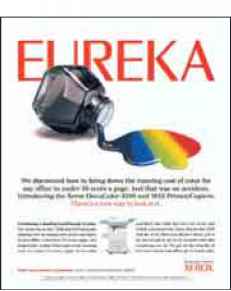Standard Learning Hierarchy
consumer will do (e.g., actual trial or purchase). In this hierarchy, the consumer is viewed as an active participant in the communication process who gathers information through active learning.
Ray suggests the standard learning hierarchy is likely when the consumer is highly involved in the purchase process and there is much differentiation among competing brands. High-involvement purchase decisions such as those for industrial products and services and consumer durables like personal computers, printers, cameras, appliances, and cars are areas where a standard learning hierarchy response process is likely. Ads for products and services in these areas are usually very detailed and provide customers with information that can be used to evaluate brands and help them make a purchase decision (Exhibit 5-6).
The Dissonance/Attribution Hierarchy A second response hierarchy proposed by Ray involves situations where consumers first behave, then develop attitudes or feelings as a result of that behavior, and then learn or process information that supports the behavior. This dissonance/attribution model, or do ^ feel ^ learn, occurs in situations where consumers must choose between two alternatives that are similar in quality but are complex and may have hidden or unknown attributes. The consumer may purchase the product on the basis of a recommendation by some nonmedia source and then attempt to support the decision by developing a positive attitude toward the brand and perhaps even developing negative feelings toward the rejected alternative(s). This reduces any postpurchase dissonance or anxiety the consumer may experience resulting from doubt over the purchase (as discussed in Chapter 4). Dissonance reduction involves selective learning, whereby the consumer seeks information that supports the choice made and avoids information that would raise doubts about the decision.
According to this model, marketers need to recognize that in some situations, attitudes develop after purchase, as does learning from the mass media. Ray suggests that in these situations the main effect of the mass media is not the promotion of original choice behavior and attitude change but rather the reduction of dissonance by reinforcing the wisdom of the purchase or providing supportive information. For example, the ad shown in Exhibit 5-7 reinforces consumers' decisions to purchase Michelin tires by showing the number of awards the brand has received for customer satisfaction.

Exhibit 5-6 Ads for high-involvement products provide consumers with information to help them evaluate brands
■ Exhibit 5-7 This ad reinforces the wisdom of the decision to purchase Michelin tires
Continue reading here: Implications of the Alternative Response Models
Was this article helpful?
Readers' Questions
-
august1 year ago
- Reply
-
Elfstan Puddifoot1 year ago
- Reply
-
monika hahn1 year ago
- Reply
-
taija liukko1 year ago
- Reply
-
Timba1 year ago
- Reply
-
KAREN WALKER1 year ago
- Reply
-
laura1 year ago
- Reply